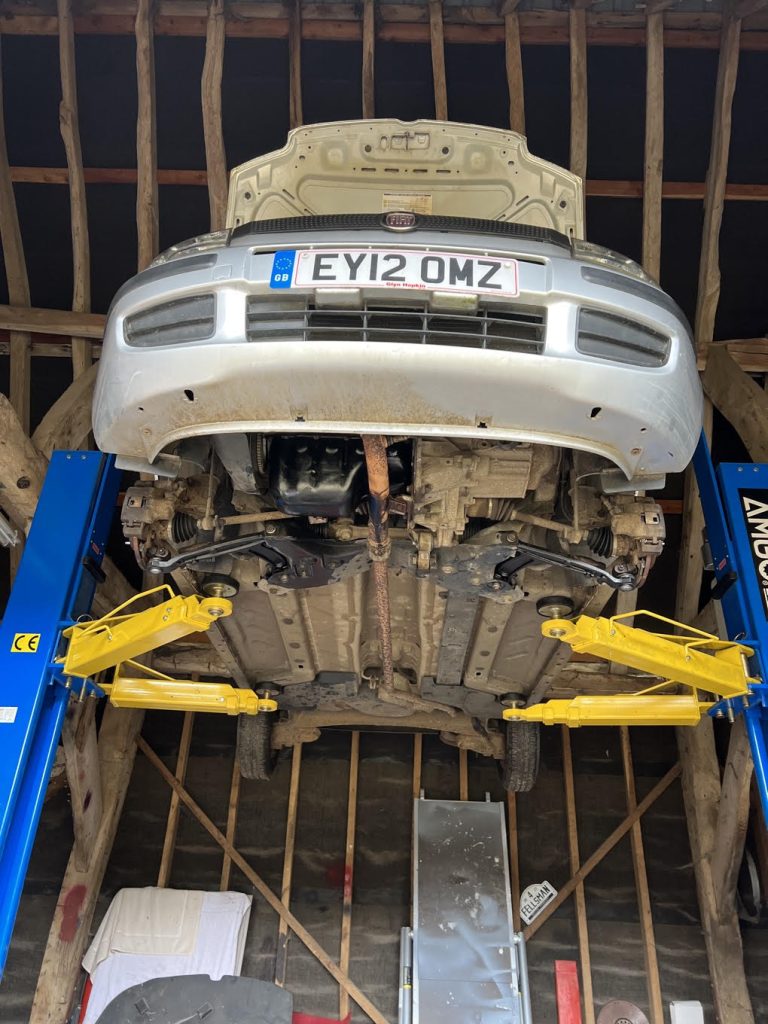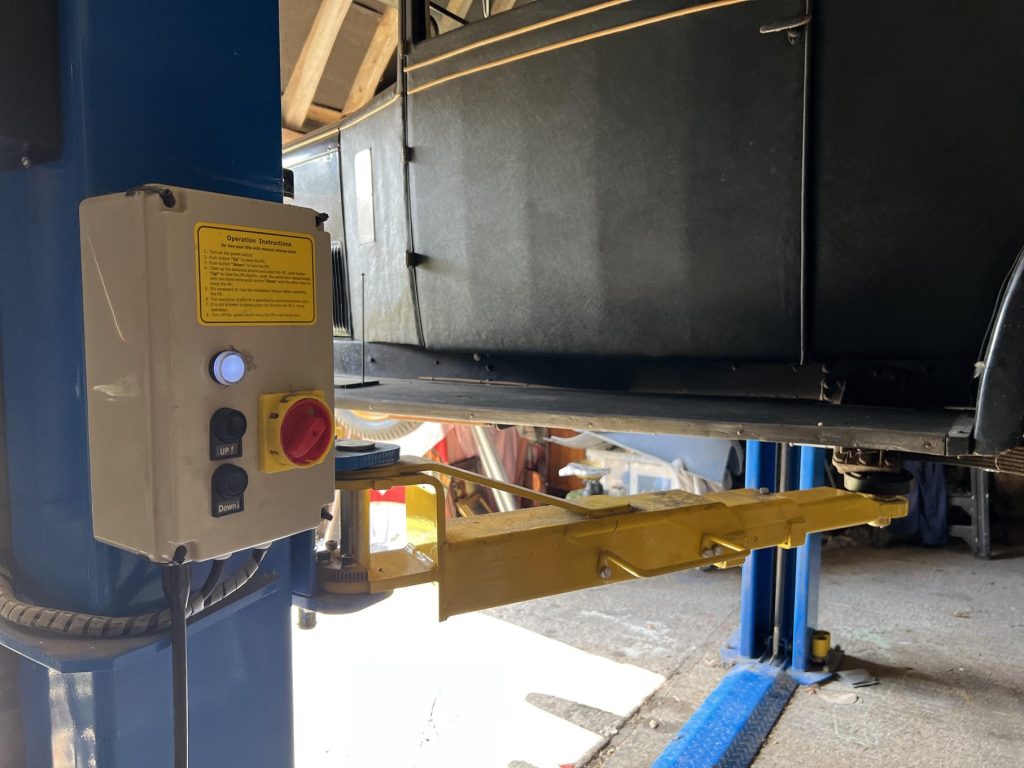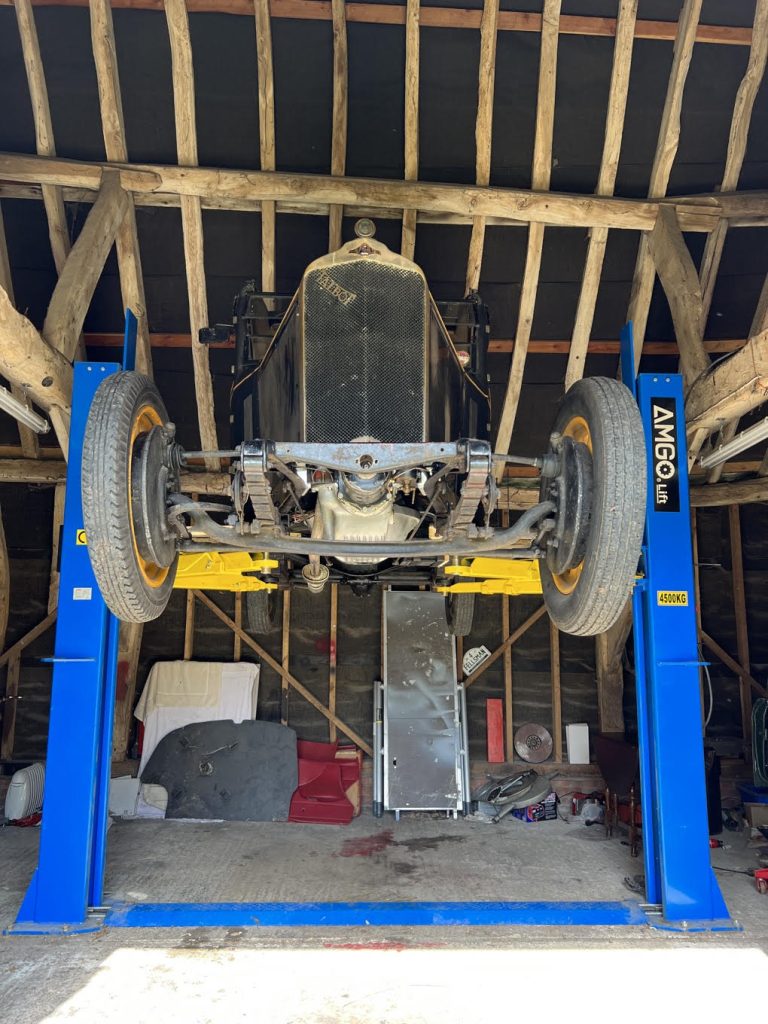I have just experienced the ultimate tool for classic car owners, and it has spoiled me forever. I lay awake at night working out how I can make the man maths work to buy one, and where to put it.
As you may have guessed from the pictures I’m not talking about a 10mm spanner or a torque wrench. The new favourite is a bit too big for a tool box, but makes everything you will ever do on your car much easier. It’s a car lift.

These are the devices you will see in every professional workshop and mean you can raise the car up to a safe and comfortable height to do everything from changing an exhaust to cleaning your wheels.
I first tried one recently when faced with a seemingly insignificant problem with my 2012 Fiat Panda. Despite having just 32,000 miles, it had a rust problem. It’s not the bodywork which is the issue – it’s the engine. For reasons best known to Fiat, the sump and a coolant pipe are made from thinly-painted steel which begins to corrode and leak vital fluids.
The parts themselves cost laughably little – as everything on the Panda does – but fitting them is a different matter. The exhaust manifold has to be dropped and part of the gearbox housing has to come off too. Doing both the pipe and the sump together would have been at least six hours labour at a garage.


I also knew that the suspension arms needed renewing before the MoT, so started totting up the totals. With the garage’s mark-up on the parts, I reckoned the bill would be more than £1000. That’s more than the car cost me. But the thought of endless crawling around under an old Fiat didn’t fill me with joy.
I was talking about this with a friend I see while walking the dog and he said the magic words: “You can borrow my ramp if you like. It makes life much easier.”
My mate bought his lift a year ago after doing a bit of research and it cost him £1500, fitted, which seems remarkably good value. His purchase justification was that, besides making repairs easier, it would also double the car capacity of his garage. That’s perfect classic car collector logic.
His is officially called a two-post lift as it has two uprights with a pair of arms on each. These swing out and adjustable pads position under jacking points. Then you press a button and the car lifts effortlessly into the air.
There are other alternatives, the most obvious being a four post lift. It has – you guessed it – four posts, which means it can generally take bigger weights and doesn’t need such serious floor mounting points. This could be crucial if you don’t want to be laying new concrete.

It’s also much quicker to get the car up in the air, as the lift generally has ramps onto which you drive. This can be a bit safer too, as you’re not having to rely on your car’s potentially dubious jacking points to support itself.
The four posters are great if you are doing a job like changing an exhaust but are less convenient if you need to take the wheels off. Generally, they have a sliding jack which moves to slot under a central point of the car – you’ve probably seen these in action while biting your nails at the MoT station.
There is also a single post option, although these are about £1000 more expensive than a two-poster. The advantage is that you don’t have a second lump of metal causing disruption in the middle of your garage. The downside it that the supporting arm goes across the width of the car, making it impossible to do some jobs like changing a propshaft or exhaust.
There are plenty of used ramps for sale on eBay, Facebook and at special auctions but be careful that they have had a safety inspection. Also be aware that a 3-phase lift is unlikely to work in a domestic garage as it needs industrial-grade 32A power input or a convertor. A single-phase 240v is what you’d need to work with a three-pin plug.
The big drawback to both all the lifts is that they need height, and if – like me – your garage is no taller than a normal room then you won’t be able to use one unless you (or your car) are unusually short.
The old-fashioned alternative is to dig a pit, but this is a lot of effort and won’t be feasible if you have pipes, cable or drainage issues caused by a low water table. It also involves a lot of climbing in and out for a job like my Panda’s, which will soon become tiring.



Another option are low rise lifts. These are often portable, adding to their usefulness, but only raise the car by a few feet. This is great for working on brakes, suspension and wheels or welding up sills, but not quite so good if you need to get right under the car. Still, they are easier than trolley jacks and axle stands.
There are various different types available, starting at around £500 for the most basic. They can be raised and lowered using a manual crank if you are up for a workout or a socket mounted on a power tool. Alternatives using hydraulics (such as QuickJack lifts) are more expensive and overlap with the price of the cheapest two-post lifts, but have the advantage of being portable.
As they generally have a flat platform which lifts on the sills, you need to make sure these low lifts will work with your cars and won’t snag body kit skirts or sit awkwardly on a curved chassis rail.
Whichever you choose, it could soon pay for itself in saved labour costs by making jobs which you just couldn’t face suddenly seem far more feasible. While I was under the Panda I also noticed the start of some other surface rust, which was easy and simple to tackle when the car was six feet in the air. It means I’ve probably saved myself a little welding job three years in the future, or ensured my car is a survivor rather than scrap further down the line.
Justifying the cost of the lift is the easy part. Now, how much does it cost to raise the garage roof by a few feet….?
Check out the Hagerty Media homepage for daily news, features, interviews and buying guides, or better still, bookmark it.










Lovely MG ZS (the “proper” one) in the last image – same colour as mine ! 🙂
You’ve not mentioned scissor lifts. These are a good compromise between the accessibility of a 2post lift, concrete floor requirements of a 4 post and lower height requirements. As they’re mostly flat, they take up less room in a garage and doesn’t stop cars still being parked next to each other.
They’re a popular option for DIY’ers for all these reasons.
Lovely old Talbot in your pics. Great to see these quality cars, not so well known today, built in West Kensington for the discerning owner. Have fun with it! Check out http://www.talbotownersclub.com